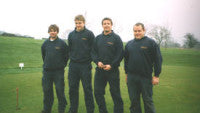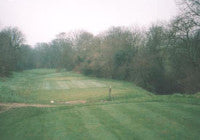From Farmer to Greenkeeper at Bracken Ghyll GC
From Farmer to Greenkeeper at Bracken Ghyll GC
By David Markham

Some 12 years ago sheep grazed on farm land above the village of Addingham in the lovely Wharfe valley.
There is nothing remarkable about that you might say except that the land is now an 18-hole golf course - yet another example of farm land being converted to other uses.
The man who master minded this transformation is Bracken Ghyll's Head Greenkeeper Rob Walker, who worked on the farm before his parents, John and Chloe, decided to turn to golf.
Originally it was a nine-hole course, but they decided to expand to 18 holes, and now Rob and his staff are gradually converting temporary greens into permanent greens.
Rob said: "I have been Head Greenkeeper since the course was made in 1992. I was a sheep farmer on my parents' farm and I used to go out and shear the sheep for other people and try and do whatever I could to make a living.
"Dad's idea was to make it into a golf course and I went to Askham Bryan College near York to do a greenkeeping course. In the first year we started on temporary greens while we made permanent greens. We employed a contractor to help to build the greens, and some friends helped with summer jobs to get the course started, and now we have built up a staff of four of us.
"We advertised for members and built up a membership. We started by hiring a portakabin and progressed to a log cabin, which is now a members' bar. A good friend of the family, Ian Crawford, a member at Ilkley Golf Club - three miles away - provided us with the log cabin that he didn't want so we took it down plank by plank and re-built it as a bar and Ian became the first president of the club. I have done everything from screwing on the optics to greenkeeping!
"When we extended from nine to 18 holes we started by taking some farm walls out. We received planning permission and started to shape temporary greens and build up the fairways. We turfed all the tees with existing turf and rotavated to level the land. We made a fence for the sheep and some time later the sheep came off the land.
"The club have a policy of trying to make one new green per year and that has happened over the last three years. It is a continuing development. As a small team we build everything ourselves. We made nine temporary greens and then year by year we are making new permanent greens USGA type with 70 per cent sand and 30 per cent soil with a 1742 root zone. We drain the greens by using a 80mm perforated type of pipe drain topped off with clean 10mm pea gravel. On top of that we put a blinding grit 50mm deep. We seed on top of the 1742 root zone to grow the turf.
"The nature of the land is clay so we cannot do much work in winter because the ground is so wet and we would do a lot of damage. So, we do much of the work in the summer and that means working a lot of hours - sometimes 70 hours a week - but it keeps the club developing and that is the main thing.
"It is such a competitive market that you have got to be seen to be doing things to keep the membership happy.
"I do the construction during the day and catch up with my day time work in the evening. We put in new bunkers and drainage with new dykes and small ponds. The bunkers are of soil and sand with pipe drains underneath.
"We installed a major drainage system in the form of a dyke down the middle of the course. That forms the backbone of the drainage system. First, we stripped off the turf and then the top soil. We then dug out the dyke and re-turfed the bankings with the turf we had taken off. It is a quick operation and very effective.
"I farmed this land all my life so I know where the wet areas are, which piece of land is going to hold water and which is not.

"We are also developing the club and we have more than 300 members, which is not bad for a new club. We have no professional - members who need a professional go down the road to Ilkley - and volunteers run the bar. We also have equal rights for men and women - it is something like a family set-up.
"The club have invested a lot of money since we expanded to 18 holes. We have two Ford tractors, a Jacobsen greens mower, a John Deere mower 2653 for surrounds and tees, a Kubota compact tractor STA 30 and a new Allman sprayer."
The club have had a particular problem with the soil on the 17th green. Rob said: "There was a black layer where the soil had become anaerobic or sour at a certain level and it wouldn't allow the grass to grow through it. You cure the problem by breaking through the ground through aeration. There are a few products on the market, but we did it through natural methods using charcoal to absorb toxin to sweeten the soil. The problem was we couldn't get the roots to grow through the anaerobic layer. The cause of the problem was thatch in the turf, which became compacted."
Photo 1: Greenkeeping staff (from left) Andy Cox, Tom Smith, Head Greenkeeper Rob Walker, Ian Newman.
Photo 2: View of the 17th hole from the tee. The tricky picture hole is 145 yards long.
